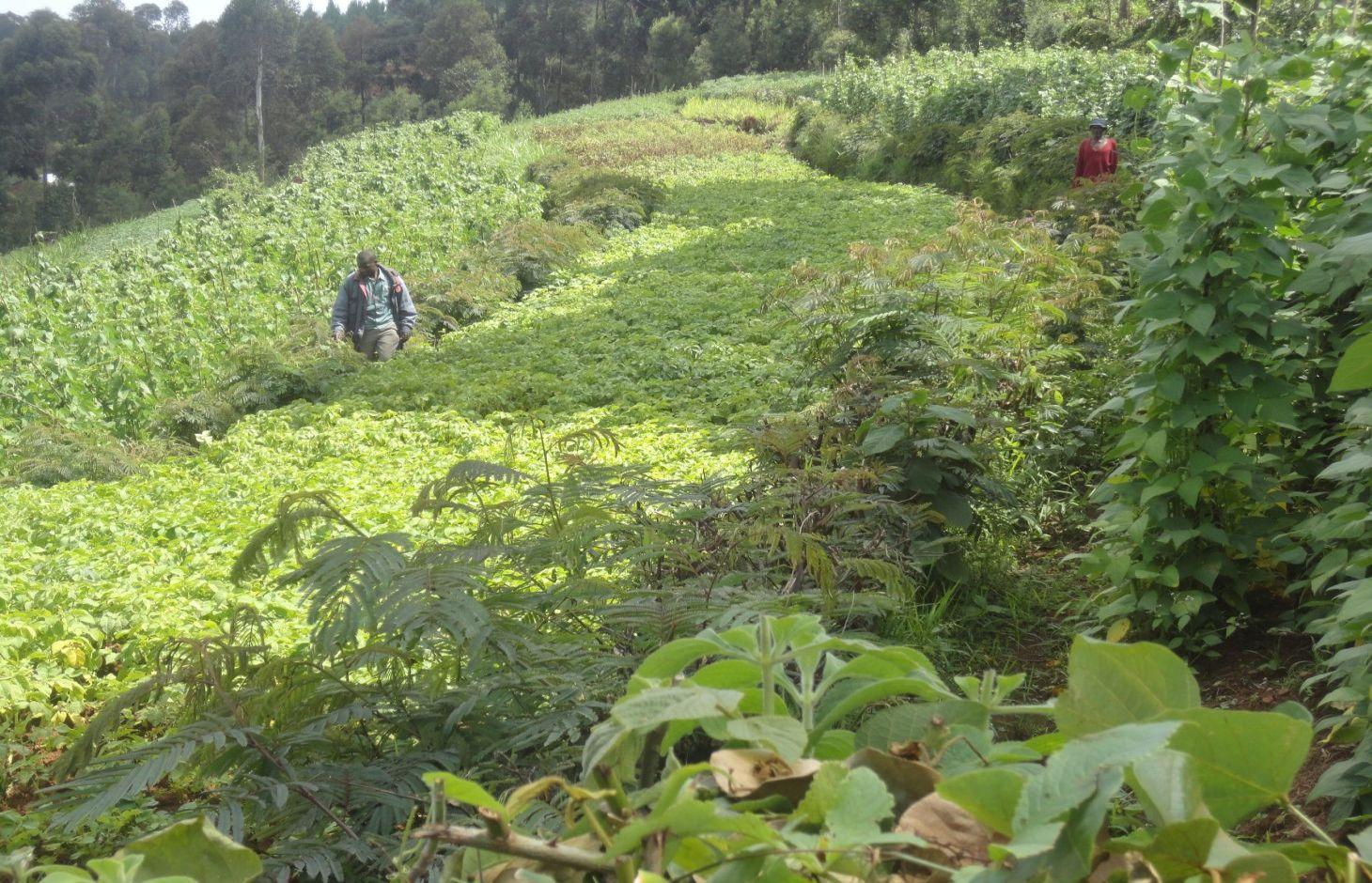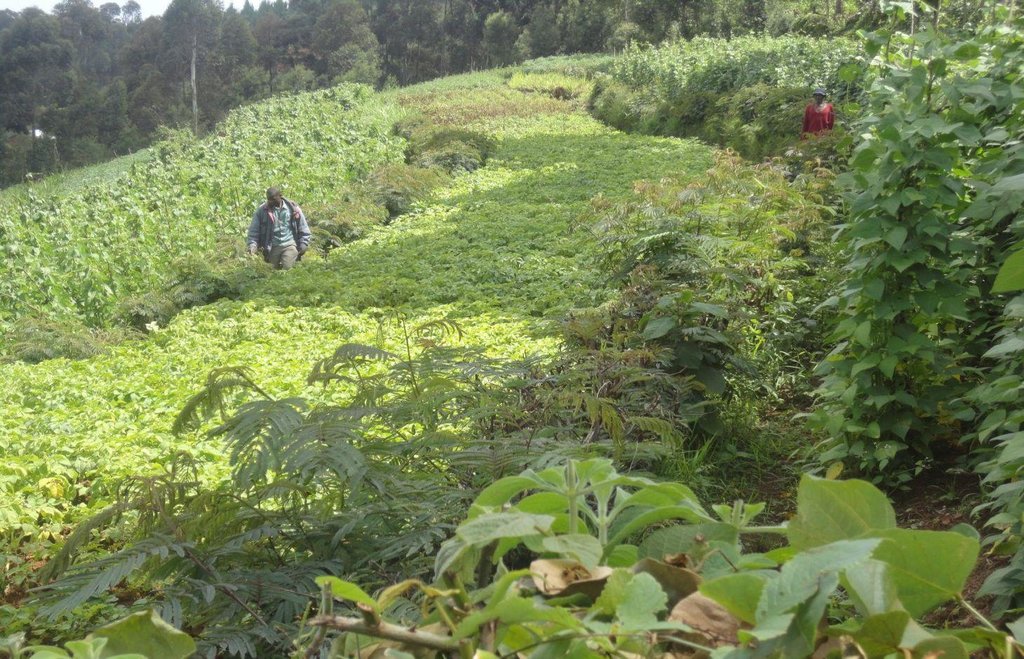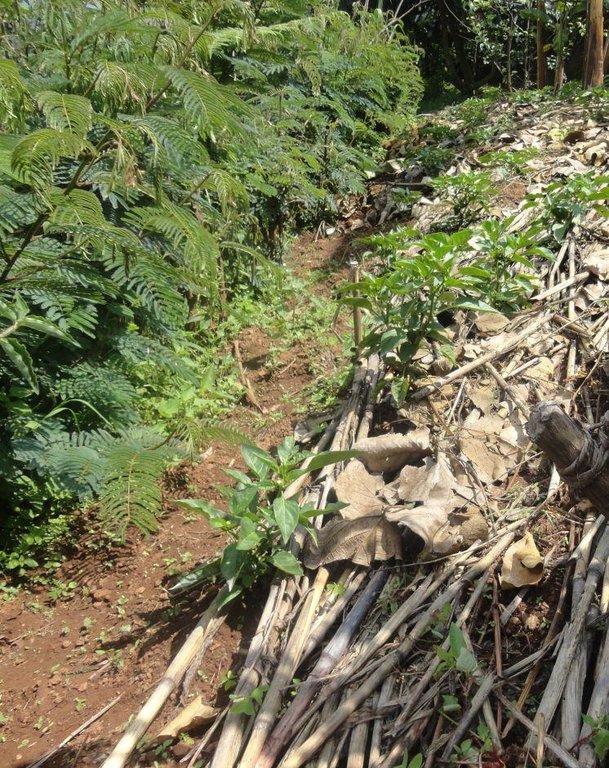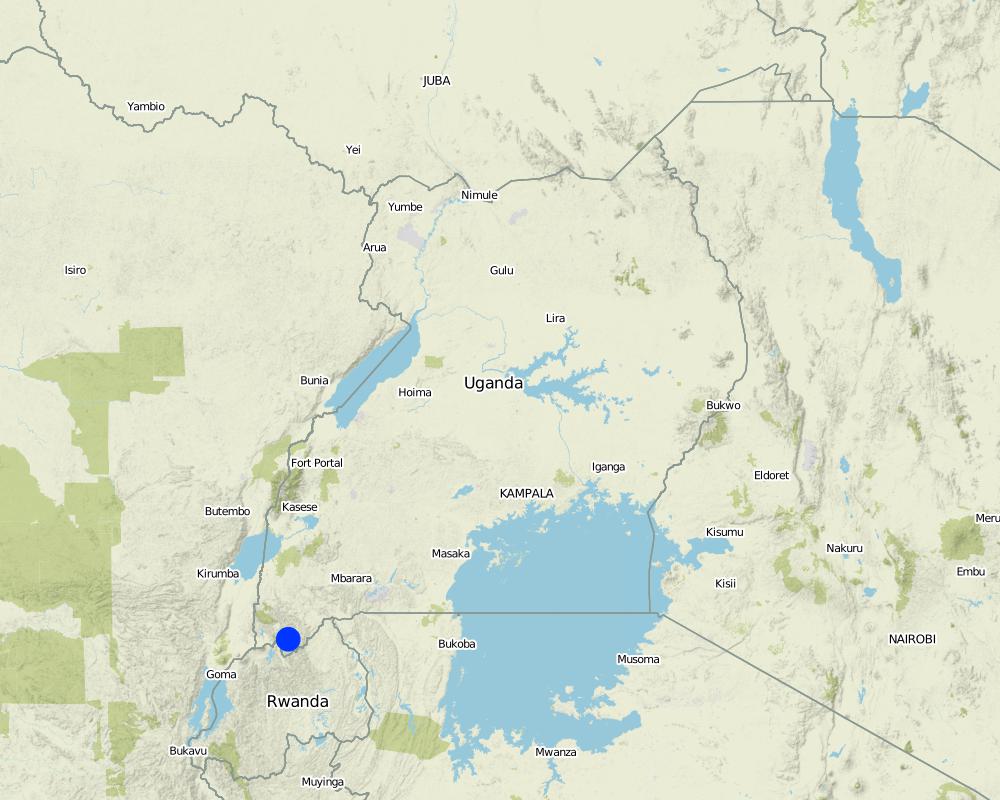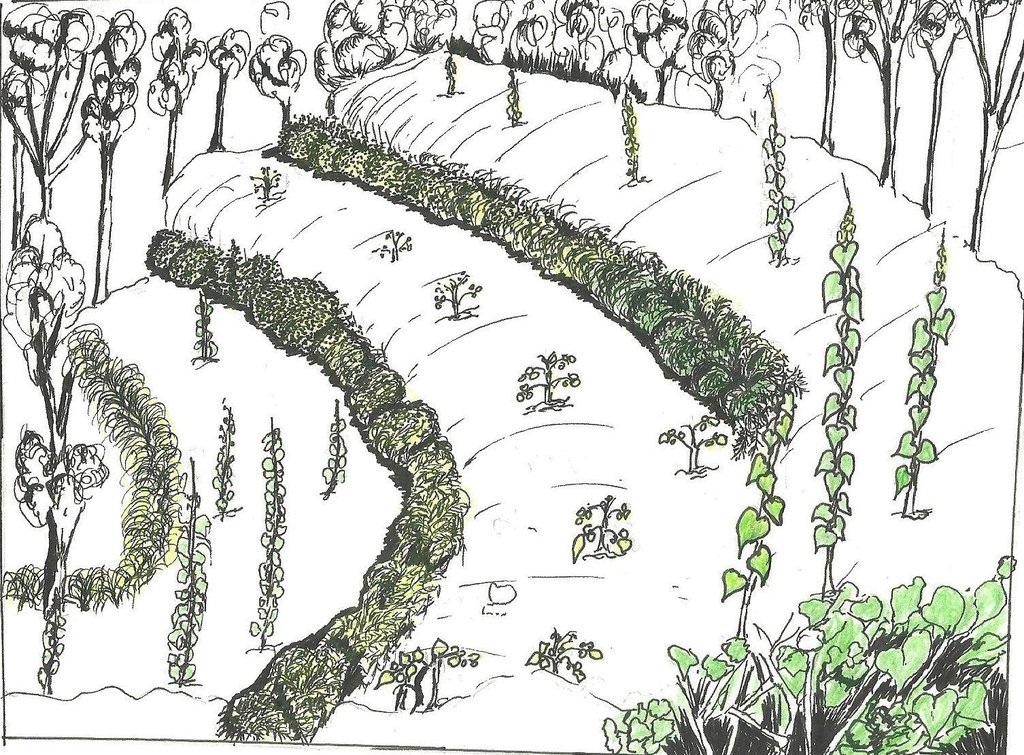Calliandra contour hedges [Ouganda]
- Création :
- Mise à jour :
- Compilateur : Wilson Bamwerinde
- Rédacteur : –
- Examinateur : Alexandra Gavilano
Orugo rwa Calliandra (Rukiga)
technologies_1178 - Ouganda
Voir les sections
Développer tout Réduire tout1. Informations générales
1.2 Coordonnées des personnes-ressources et des institutions impliquées dans l'évaluation et la documentation de la Technologie
Nom du projet qui a facilité la documentation/ l'évaluation de la Technologie (si pertinent)
The Transboundary Agro-ecosystem Management Project for the Kagera River Basin (GEF-FAO / Kagera TAMP )Nom du ou des institutions qui ont facilité la documentation/ l'évaluation de la Technologie (si pertinent)
FAO Food and Agriculture Organization (FAO Food and Agriculture Organization) - ItalieNom du ou des institutions qui ont facilité la documentation/ l'évaluation de la Technologie (si pertinent)
Kabale District Local Government (Kabale District Local Government) - Ouganda1.3 Conditions relatives à l'utilisation par WOCAT des données documentées
Le compilateur et la(les) personne(s) ressource(s) acceptent les conditions relatives à l'utilisation par WOCAT des données documentées:
Oui
2. Description de la Technologie de GDT
2.1 Courte description de la Technologie
Définition de la Technologie:
Contour hedges of Calliandra planted on very steep slopes to combat soil erosion by decreasing surface runoff and increasing infiltration.
2.2 Description détaillée de la Technologie
Description:
Calliandra Calothyrsus trees are closely planted along the contours on hilly and steep slopes to create natural and effective barriers for reduction of the surface runoff and retention of eroded sediment. Calliandra hedge barriers are a fairly cheap, effective, and sustainable way of controlling soil erosion and landslides on vulnerable steep slopes, especially where trash lines and Napier grass strips were inadequate to mitigate dispersed and concentrated soil and water runoff. Once established, the living barrier is durable with minimal additional maintenance cost to the farmer apart from pruning. The average length of a hedgerow is 50 to 70 m, corresponding to the width of a single terrace. The height varies according to intended use of the mature shoots. To use the stems as stakes, the hedgerow is allowed to reach a height of 4 to 6 m at maturity while a height of 1 to 2 m is sufficient for harvesting foliage as livestock fodder. The hedge barrier reaches its mature, maintenance level after 12 to 18 months.
Purpose of the Technology: The main purpose of the Calliandra hedge barrier is to reduce soil and water runoff.Calliandra is a leguminous shrub with deep roots that provids additional benefits such as soil stabilization and soil fertility improvement through nitrogen fixing. Calliandra is a source of fodder and its flowers attract bees.
Establishment / maintenance activities and inputs: At the beginning of the rainy season, calliandra seedlings are transplanted from the nursery (0.2m to 0.3m height) and planted in a row (0.3m spacing). In the early stages, gap-filling with more seedlings may be necessary as some fail to get established. A mixture of top soil and manure is applied in the spaces between the seedlings and watering is done to improve the seedling survival rate. The distance between rows is 10 to 15 m and depends on the gradient of the slope. Establishment of hedges starts with construction of an earth banked terrace, creating a trench at the lower end of the terrace. Calliandra seedlings are planted on the higher side of the trench. Measuring off 10 m lengths upwards into the terrace, other rows of Calliandra seedlings are planted along the contour in order to achieve the inter-row spacing. Establishment is manual labor intensive and therefore the community, organized as Farmer Field Schools, participates in the planting, one field at a time. Simple tools such as hand hoes, sokajembe (pick-axe) and shovels are used. Maintenance is achieved by weeding, mulching and cutting back. For it to establish well, Calliandra needs to be weeded to minimize competition with weeds for water and nutrients . The weeds also harbour pests. It may also be necessary to mulch the area around each seedling during the dry season. Where mulching is done, the mulch is placed at least 0.05m away from the plant to reduce pest attacks. Calliandra calothyrsus trees are cut back at a height of 2m to between 0.15m and 1m to improve foliage which is used as fodder for livestock. The hedge is then maintained at a height of 1 to 6 m depending on the intended additional uses. The branches removed can be used as fuel wood or stakes, while leaves can be used as fodder.
Natural / human environment: The hedge barrier may be attacked by pests. Scales are white, powdery insects that attack Calliandra stems. Scales can be controlled using washing detergents such as ‘Omo’ dissolved in water and sprinkled on affected plants using leafy branches or a knapsack sprayer. Black ants can seriously damage trees. They can be controlled by spraying. Other likely pests are crickets and grass hoppers which affect seedlings in nurseries, and Armillaria mellea, a fungus that attacks roots of Calliandra plant causing root rot and eventual death. Affected plants are uprooted and burnt. In addition, calliandra is affected by hot, dry weather. During the hot, dry weather, the hedge barrier becomes weak. However during the wet season it sprouts again, and, if well managed, becomes healthy again. A well-maintained hedge barriers can last well over 20 years.
2.3 Photos de la Technologie
2.5 Pays/ région/ lieux où la Technologie a été appliquée et qui sont couverts par cette évaluation
Pays:
Ouganda
Région/ Etat/ Province:
Uganda
Autres spécifications du lieu:
Kabale District
Commentaires:
Boundary points of the Technology area: -1.29294, 29.96006
-1.29336, 29.96027
-1.29327, 29.96084
Total area covered by the SLM Technology is 0.03 km2.
The documented case study area is around 3ha
-1.29371, 29.96095
-1.29345, 29.96091
Map
×2.6 Date de mise en œuvre de la Technologie
Si l'année précise est inconnue, indiquez la date approximative: :
- il y a moins de 10 ans (récemment)
2.7 Introduction de la Technologie
Spécifiez comment la Technologie a été introduite: :
- par le biais de projets/ d'interventions extérieures
Commentaires (type de projet, etc.) :
The technology was introduced by ICRAF in 2006 and scaled-up Kagera TAMP project 2 years ago.
3. Classification de la Technologie de GDT
3.2 Type(s) actuel(s) d'utilisation des terres, là où la Technologie est appliquée

Terres cultivées
- Cultures annuelles
- Plantations d’arbres ou de buissons
Cultures annuelles - Précisez les cultures:
- cultures fourragères - autres
- légumineuses et légumes secs - fèves
Plantations d'arbres et d'arbustes - Précisez les cultures:
- arbres fourragers (Barbe jolote, Faux mimosa, Prosopis, etc.)
Nombre de période de croissance par an: :
- 2
Précisez:
Longest growing period in days: 120Longest growing period from month to month: February to MaySecond longest growing period in days: 90Second longest growing period from month to month: September to November

Pâturages
Pâturage intensif/ production fourragère :
- Prairies améliorées
- Livestock is grazing on crop residues
Commentaires:
Livestock density (if relevant):
1-10 LU /km2
Major land use problems (compiler’s opinion): The slopes are steep >30% to very steep >60%), with very high precipitation (>1440 mm). Severe surface erosion and landslides may occur at the beginning of the rains, before sufficient vegetation covers the soil. Continuous cultivation with little external inputs and nutrient transfer affects negatively soil fertility and in results reduces crops growth/vegetation cover, leading to erosion on steep slopes.
Major land use problems (land users’ perception): Floods are common in the valleys over the past ten years.
Improved pasture: Diary hiefers,pigs(largewhite and layers)pasture include calliandra,stellia and elephant grass.
Constraints of settlement / urban: floods invade houses
Constraints of infrastructure network (roads, railways, pipe lines, power lines): transport problem
3.4 Approvisionnement en eau
Approvisionnement en eau des terres sur lesquelles est appliquée la Technologie:
- pluvial
3.6 Mesures de GDT constituant la Technologie

pratiques végétales
- V1: Couverture d’arbres et d’arbustes
Commentaires:
Type of vegetative measures: aligned: -contour
3.7 Principaux types de dégradation des terres traités par la Technologie

érosion hydrique des sols
- Wt: perte de la couche superficielle des sols (couche arable)/ érosion de surface
- Wm: mouvements de masse/ glissements de terrain
Commentaires:
Main causes of degradation: soil management (Poor vegetative cover/no trees to bind soil particles.), Heavy / extreme rainfall (intensity/amounts) (Rainfall intensifying in september and April.), other natural causes (avalanches, volcanic eruptions, mud flows, highly susceptible natural resources, extreme topography, etc.) specify (steep slopes (extreme topography)), population pressure (Population increase/no of people increased per sq km), poverty / wealth (lack of resources to implement known natural resources degradation mitigation measures)
Secondary causes of degradation: education, access to knowledge and support services
3.8 Prévention, réduction de la dégradation ou réhabilitation des terres dégradées
Spécifiez l'objectif de la Technologie au regard de la dégradation des terres:
- prévenir la dégradation des terres
- réduire la dégradation des terres
4. Spécifications techniques, activités, intrants et coûts de mise en œuvre
4.1 Dessin technique de la Technologie
Spécifications techniques (associées au dessin technique):
Calliandra trees are planted in rows along the contour. Cutting back is done between 12 and 18 months to a height of 0.5 m. The trees are allowed to grow to between 1 and 6 m and the hedge is maintained at that height. Gap-filling, weeding and trimming are critical for a productive hedge.
Location: Bukoora, Kabale. Kabale/Uganda
Technical knowledge required for field staff / advisors: moderate (Such knowledge as is required to manage the Calliandra nursery, transplant and maintain the plants especially until the first coppice.)
Technical knowledge required for land users: moderate (The land user is responsible for maintaining the technology on his or her land and a good hedge requires diligence)
Main technical functions: control of dispersed runoff: impede / retard, control of concentrated runoff: impede / retard, improvement of ground cover, improvement of topsoil structure (compaction), stabilisation of soil (eg by tree roots against land slides), increase in nutrient availability (supply, recycling,…)
Secondary technical functions: control of raindrop splash, reduction of slope angle, reduction of slope length, increase of infiltration, increase of groundwater level / recharge of groundwater, sediment retention / trapping, sediment harvesting, increase of biomass (quantity)
Aligned: -contour
Vegetative material: T : trees / shrubs
Number of plants per (ha): 670 to 720
Spacing between rows / strips / blocks (m): 10
Vertical interval within rows / strips / blocks (m): 0.4
Width within rows / strips / blocks (m): 0.7
Trees/ shrubs species: Calliandra was planted
Fruit trees / shrubs species: n/a
Perennial crops species: n/a
Grass species: n/a
Other species: n/a
Slope (which determines the spacing indicated above): 40%
If the original slope has changed as a result of the Technology, the slope today is (see figure below): n/a%
Gradient along the rows / strips: <3%
Auteur:
Byonabye, Prossy, Kagera TAMP, Kabale, Uganda
Date:
2013-11-29
4.2 Informations générales sur le calcul des intrants et des coûts
autre/ monnaie nationale (précisez):
UGX
Indiquez le taux de change des USD en devise locale, le cas échéant (p.ex. 1 USD = 79.9 réal brésilien): 1 USD = :
2602,0
Indiquez le coût salarial moyen de la main d'œuvre par jour:
3.80
4.3 Activités de mise en place/ d'établissement
| Activité | Calendrier des activités (saisonnier) | |
|---|---|---|
| 1. | Establishment of Calliandra nursery | Dry season |
| 2. | Plantation of Calliandra seedling on the higher side of the trench | Wet season |
| 3. | Weeding |
4.4 Coûts et intrants nécessaires à la mise en place
| Spécifiez les intrants | Unité | Quantité | Coûts par unité | Coût total par intrant | % du coût supporté par les exploitants des terres | |
|---|---|---|---|---|---|---|
| Main d'œuvre | Labour | 1,0 | 44,6 | 44,6 | 100,0 | |
| Equipements | tools | 1,0 | 16,2 | 16,2 | 100,0 | |
| Matériel végétal | seedlings | 1,0 | 30,4 | 30,4 | 100,0 | |
| Matériel végétal | seeds | 1,0 | 9,6 | 9,6 | 100,0 | |
| Coût total de mise en place de la Technologie | 100,8 | |||||
| Coût total de mise en place de la Technologie en dollars américains (USD) | 0,04 | |||||
Commentaires:
Duration of establishment phase: 18 month(s)
4.5 Activités d'entretien/ récurrentes
| Activité | Calendrier/ fréquence | |
|---|---|---|
| 1. | Prunning and triming the hedge barriers | wet/dry season |
4.6 Coûts et intrants nécessaires aux activités d'entretien/ récurrentes (par an)
| Spécifiez les intrants | Unité | Quantité | Coûts par unité | Coût total par intrant | % du coût supporté par les exploitants des terres | |
|---|---|---|---|---|---|---|
| Main d'œuvre | labour | 1,0 | 20,8 | 20,8 | 100,0 | |
| Equipements | tools | 1,0 | 16,2 | 16,2 | 100,0 | |
| Matériel végétal | seedlings | 1,0 | 1,0 | 1,0 | 100,0 | |
| Autre | 100,0 | |||||
| Coût total d'entretien de la Technologie | 38,0 | |||||
| Coût total d'entretien de la Technologie en dollars américains (USD) | 0,01 | |||||
Commentaires:
Machinery/ tools: I panga,1 watering can, 1hoe.
The cost assesment above refers to steep slopes.
4.7 Facteurs les plus importants affectant les coûts
Décrivez les facteurs les plus importants affectant les coûts :
The cost of seedlings (0.20 US$ each) and their transport up along steep slopes are the key factors affecting costs and hindering spontaneous adoption of the technology. Otherwise, the technology is acceptable to farmers as benefits are easily visible in the short run.
5. Environnement naturel et humain
5.1 Climat
Précipitations annuelles
- < 250 mm
- 251-500 mm
- 501-750 mm
- 751-1000 mm
- 1001-1500 mm
- 1501-2000 mm
- 2001-3000 mm
- 3001-4000 mm
- > 4000 mm
Zone agro-climatique
- subhumide
Thermal climate class: tropics. at the Equator
5.2 Topographie
Pentes moyennes:
- plat (0-2 %)
- faible (3-5%)
- modéré (6-10%)
- onduleux (11-15%)
- vallonné (16-30%)
- raide (31-60%)
- très raide (>60%)
Reliefs:
- plateaux/ plaines
- crêtes
- flancs/ pentes de montagne
- flancs/ pentes de colline
- piémonts/ glacis (bas de pente)
- fonds de vallée/bas-fonds
Zones altitudinales:
- 0-100 m
- 101-500 m
- 501-1000 m
- 1001-1500 m
- 1501-2000 m
- 2001-2500 m
- 2501-3000 m
- 3001-4000 m
- > 4000 m
5.3 Sols
Profondeur moyenne du sol:
- très superficiel (0-20 cm)
- superficiel (21-50 cm)
- modérément profond (51-80 cm)
- profond (81-120 cm)
- très profond (>120 cm)
Texture du sol (de la couche arable):
- grossier/ léger (sablonneux)
- moyen (limoneux)
Matière organique de la couche arable:
- moyen (1-3%)
- faible (<1%)
5.4 Disponibilité et qualité de l'eau
Profondeur estimée de l’eau dans le sol:
> 50 m
Disponibilité de l’eau de surface:
faible/ absente
5.5 Biodiversité
Diversité des espèces:
- faible
5.6 Caractéristiques des exploitants des terres appliquant la Technologie
Orientation du système de production:
- exploitation mixte (de subsistance/ commerciale)
Revenus hors exploitation:
- moins de 10% de tous les revenus
Niveau relatif de richesse:
- pauvre
- moyen
Individus ou groupes:
- individu/ ménage
Niveau de mécanisation:
- travail manuel
Genre:
- femmes
- hommes
Indiquez toute autre caractéristique pertinente des exploitants des terres:
Difference in the involvement of women and men: Maintenance such as pruning trimming is mostly done by the men, but the other activities are done by both men and women.
Population density: 200-500 persons/km2
Annual population growth: 2% - 3%; 3%
5% of the land users are rich and own 40% of the land.
30% of the land users are average wealthy and own 30% of the land (meets basic needs/necesities).
45% of the land users are poor and own 20% of the land.
20% of the land users are poor and own 10% of the land.
Off-farm income specification: Crop and animal production greatly increased for land users implementing conservation measures , compared to those who do not implement.
5.7 Superficie moyenne des terres utilisées par les exploitants des terres appliquant la Technologie
- < 0,5 ha
- 0,5-1 ha
- 1-2 ha
- 2-5 ha
- 5-15 ha
- 15-50 ha
- 50-100 ha
- 100-500 ha
- 500-1 000 ha
- 1 000-10 000 ha
- > 10 000 ha
Cette superficie est-elle considérée comme de petite, moyenne ou grande dimension (en se référant au contexte local)?
- petite dimension
5.8 Propriété foncière, droits d’utilisation des terres et de l'eau
Propriété foncière:
- individu, sans titre de propriété
Droits d’utilisation des terres:
- individuel
Commentaires:
The land belongs to an individual with no title but has all the rights over it.
5.9 Accès aux services et aux infrastructures
santé:
- pauvre
- modéré
- bonne
éducation:
- pauvre
- modéré
- bonne
assistance technique:
- pauvre
- modéré
- bonne
marchés:
- pauvre
- modéré
- bonne
énergie:
- pauvre
- modéré
- bonne
routes et transports:
- pauvre
- modéré
- bonne
eau potable et assainissement:
- pauvre
- modéré
- bonne
services financiers:
- pauvre
- modéré
- bonne
n/an/an/an/a:
- pauvre
- modéré
- bonne
6. Impacts et conclusions
6.1 Impacts sur site que la Technologie a montrés
Impacts socio-économiques
Production
production agricole
Quantité avant la GDT:
150
Quantité après la GDT:
700
qualité des fourrages
Quantité avant la GDT:
-
Quantité après la GDT:
-
production animale
Quantité avant la GDT:
-
Quantité après la GDT:
25
surface de production
Revenus et coûts
revenus agricoles
Quantité avant la GDT:
1.5 million
Quantité après la GDT:
3.5million
Impacts socioculturels
sécurité alimentaire/ autosuffisance
connaissances sur la GDT/ dégradation des terres
Quantité avant la GDT:
-
Quantité après la GDT:
-
apaisement des conflits
Impacts écologiques
Cycle de l'eau/ ruissellement
ruissellement de surface
Sols
humidité du sol
couverture du sol
perte en sol
cycle/ recharge des éléments nutritifs
Biodiversité: végétale, animale
biomasse/ au dessus du sol C
diversité végétale
Autres impacts écologiques
increased pests
6.2 Impacts hors site que la Technologie a montrés
inondations en aval
envasement en aval
dommages sur les champs voisins
Quantité avant la GDT:
-
Quantité après la GDT:
-
dommages sur les infrastructures publiques/ privées
Quantité avant la GDT:
-
Quantité après la GDT:
-
6.3 Exposition et sensibilité de la Technologie aux changements progressifs et aux évènements extrêmes/catastrophes liés au climat (telles que perçues par les exploitants des terres)
Changements climatiques progressifs
Changements climatiques progressifs
| Saison | Augmentation ou diminution | Comment la Technologie fait-elle face à cela? | |
|---|---|---|---|
| températures annuelles | augmente | bien |
Extrêmes climatiques (catastrophes)
Catastrophes météorologiques
| Comment la Technologie fait-elle face à cela? | |
|---|---|
| pluie torrentielle locale | bien |
Catastrophes climatiques
| Comment la Technologie fait-elle face à cela? | |
|---|---|
| sécheresse | bien |
Catastrophes hydrologiques
| Comment la Technologie fait-elle face à cela? | |
|---|---|
| inondation générale (rivière) | bien |
Autres conséquences liées au climat
Autres conséquences liées au climat
| Comment la Technologie fait-elle face à cela? | |
|---|---|
| réduction de la période de croissance | pas connu |
| n/a |
6.4 Analyse coûts-bénéfices
Quels sont les bénéfices comparativement aux coûts de mise en place (du point de vue des exploitants des terres)?
Rentabilité à court terme:
négative
Rentabilité à long terme:
très positive
Quels sont les bénéfices comparativement aux coûts d'entretien récurrents (du point de vue des exploitants des terres)?
Rentabilité à court terme:
négative
Rentabilité à long terme:
positive
Commentaires:
Benefits are high compared to establishment and maintenance cost
6.5 Adoption de la Technologie
Commentaires:
88% of land user families have adopted the Technology with external material support
45 land user families have adopted the Technology with external material support
12% of land user families have adopted the Technology without any external material support
6 land user families have adopted the Technology without any external material support
There is a moderate trend towards spontaneous adoption of the Technology
Comments on adoption trend: The technology is appreciated by most farmers but adoption is limited by cost of seedlings and transportation up steep slopes
6.7 Points forts/ avantages/ possibilités de la Technologie
| Points forts/ avantages/ possibilités du point de vue de l'exploitant des terres |
|---|
|
Calliandra binds the soil, thus reduces landslides. How can they be sustained / enhanced? It should be maintained through proper management |
|
Adds scenic beauty on a plot How can they be sustained / enhanced? By regular trimming |
|
Calliandra is good and attractive to bees How can they be sustained / enhanced? Leave every second or third row to flower |
| Points forts/ avantages/ possibilités du point de vue du compilateur ou d'une autre personne ressource clé |
|---|
|
It is easy to establish and maintain How can they be sustained / enhanced? Promote education campaign and spread information |
|
It has helped to increase crop and animal production How can they be sustained / enhanced? By proper management and not overgrazing animals |
|
Stabilize the soil and strenghtening resistance to intensive rainfall and fast runoff How can they be sustained / enhanced? Promote technology through increased community mobilization |
|
Very effective to reduce soil erosion How can they be sustained / enhanced? Combine with other practicies e.g. mulching |
6.8 Faiblesses/ inconvénients/ risques de la Technologie et moyens de les surmonter
| Faiblesses/ inconvénients/ risques du point de vue du compilateur ou d'une autre personne ressource clé | Comment peuvent-ils être surmontés? |
|---|---|
| The hedge barrier is ineffective before 12 months | Combine with trash lines before establishment |
| Technology harbors nesting birds | Ensure regular trimming of Calliandra to reasonable height and use scarecrows |
| Needs at least 2 seasons to establish | Apply manure and water to the seedlings to ensure accelerated growth |
| May reduce the amount of sunlight available to young crops if left untrimmed | Trim regularly |
| Extra cost in protecting from damage by livestock | Inter-crop with other fodder species to act as alternative fodder for livestock |
7. Références et liens
7.1 Méthodes/ sources d'information
7.2 Références des publications disponibles
Titre, auteur, année, ISBN:
Kagera TAMP Project website
Disponible à partir d'où? Coût?
http://www.fao.org/nr/kagera/en/
Liens et modules
Développer tout Réduire toutLiens
Aucun lien
Modules
Aucun module trouvé


